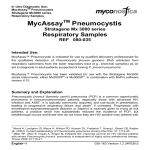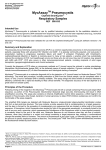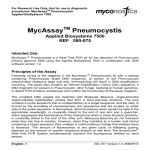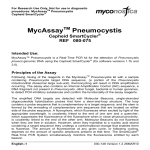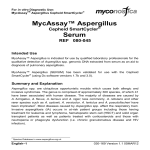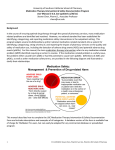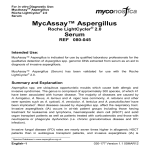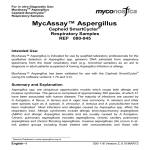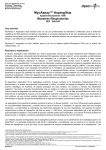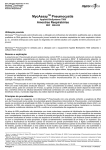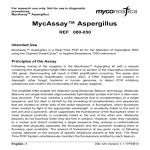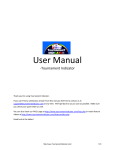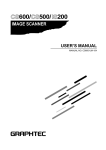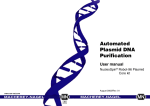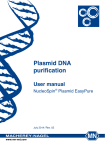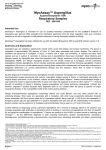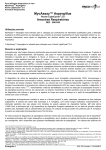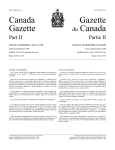Download Respiratory Samples
Transcript
For in vitro Diagnostic Use: MycAssayTM Pneumocystis Applied BioSystems 7500 Respiratory Samples MycAssayTM Pneumocystis Applied BioSystems 7500 Respiratory Samples REF 080-035 Intended Use: MycAssay™ Pneumocystis is indicated for use by qualified laboratory professionals for the qualitative detection of Pneumocystis jirovecii genomic DNA extracted from respiratory specimens from the lower respiratory tract (e.g., bronchial samples) as an aid to diagnosis in adult patients suspected of having P. jirovecii pneumonia. MycAssay™ Pneumocystis has been validated for use with the Applied BioSystems 7500 (using SDS software version 1.4). Summary and Explanation Pneumocystis jirovecii (formerly carinii) pneumonia (PCP) is a common opportunistic pneumonia in immunocompromised patients, especially those with advanced HIV infection and AIDS1. It is typically community acquired, and sub-acute in presentation, leading to progressive respiratory failure and death2 if untreated. Prophylaxis with trimethoprim-sulphamethoxazole (Bactrim or Septrin) is routinely given to many at risk patients, a practice which has substantially reduced the incidence of PCP, but breakthrough occurs and those who do not know they are HIV positive may present with 1 Morris A, Lundgren JD, Masur H, Walzer PD, Hanson DL, Frederick T, Huang L, Beard CB, Kaplan JE. (2004). Current epidemiology of Pneumocystis pneumonia. Emerg Infect Dis: 10: 1713-20. 2 Miller RF, Allen E, Copas A, Singer M, Edwards SG. Improved survival for HIV infected patients with severe Pneumocystis jirovecii. pneumonia is independent of highly active antiretroviral therapy. Thorax 2006; 61:716-21. English–1 030-149 Version 1.4 24FEB12 MycAssayTM Pneumocystis For in vitro Diagnostic Use Applied BioSystems 7500 Respiratory Samples AIDS with PCP3. PCP also occurs in other immunocompromised patients, including recipients of solid organ transplants, hypogammaglobulinaemia and chronic leukaemia. Currently the diagnosis of PCP relies on microscopic methods as P. jirovecii cannot be cultured in routine microbiology laboratories. Bronchoalveolar lavage (BAL) is the preferred means of sample collection. Common methods for diagnosis include immunofluorescence (IF) or direct fluorescence and histological staining of samples 4. MycAssayTM Pneumocystis is a molecular diagnostic kit for the detection of P. jirovecii based on Molecular Beacon5 PCR technology. The whole test procedure, including extraction of DNA from the clinical sample, can be completed within 4 hours, or only 2 hours if extracted DNA is already available. This assay brings the direct benefit of enhanced laboratory efficiency combined with a rapid test leading to likely clinical benefits. The diagnostic accuracy of the test depends to a great extent on sample quality. Principles of the Procedure Following mixing of the reagents in the MycAssayTM Pneumocystis kit with a sample containing Pneumocystis target DNA sequence, (a portion of the Pneumocystis mitochondrial ribosomal large sub-unit), thermocycling will result in DNA amplification occurring. The assay also contains an Internal Amplification Control (IAC) sequence, a DNA fragment not present in Pneumocystis, other fungal, bacterial or human genomes, to detect PCR inhibitory substances and confirm the functionality of the assay reagents. The amplified DNA targets are detected with Molecular Beacons; single-stranded oligonucleotide hybridization probes that form a stem-and-loop structure. The loop contains a probe sequence that is complementary to a target sequence, and the stem is formed by the annealing of complementary arm sequences that are located on either side of the probe sequence. A fluorophore, which fluoresces when excited by light of the appropriate wavelength, is covalently linked to the end of one arm and a quencher, which suppresses the fluorescence of the fluorophore when in close physical proximity, is covalently linked to the end of the other arm. Molecular Beacons do not fluoresce when they are free in solution. However, when they hybridise to a nucleic acid strand containing a target sequence they undergo a conformational change that enables them 3 Kovacs JA, Gill VJ, Meshnick S, Masur H. (2001). New insights into transmission, diagnosis, and drug treatment of Pneumocystis carinii pneumonia. JAMA: 286: 2450-60. 4 Huang L, Morris A, Limper AH, Beck JM; ATS Pneumocystis Workshop Participants. An Official ATS Workshop Summary: Recent advances and future directions in pneumocystis pneumonia (PCP). Proc Am Thorac Soc 2006;3:655-64. 5 Tyagi S, Kramer FR. (1996). Molecular beacons: Probes that fluoresce upon hybridization. Nature Biotechnology: 14: 303-308. 030-149 Version 1.4 24FEB12 English–2 For in vitro Diagnostic Use MycAssayTM Pneumocystis Respiratory Samples Applied BioSystems 7500 to fluoresce. The amount of fluorescence at any given cycle, or following cycling, depends on the amount of specific amplicons present at that time. The Real-Time PCR System simultaneously monitors the fluorescence emitted by each beacon. Precautions The kit is intended for use only by laboratory professionals. Procedures are required for non-aerosol manipulations of specimens. Standard precautions and institutional guidelines should be followed in handling all samples. A Material Safety Data Sheet is available from Myconostica Ltd. This test is for in vitro diagnostic use only. This test is only for use with the Applied BioSystems 7500 with SDS software version 1.4. MicroAmp® Optical PCR tube strips (see Equipment/Materials section for more details) should be used with this kit. Use of different plastic consumables could invalidate the assay results. Do not use reagents or controls if the protective pouches are open or broken upon arrival. Reagents and controls are not interchangeable between kits with differing lot numbers. Never pool reagents or controls from different tubes even if they are from the same lot. Never use the reagents or controls after their expiry date. Reagents and controls should not be refrozen or reused after opening. Wear protective clothing and disposable gloves while handling kit reagents. Avoid microbial and deoxyribonuclease (DNase) contamination of reagents when removing aliquots from tubes. The use of sterile DNase-free, low-retention disposable filter-tipped or positive displacement pipette tips is recommended. Use a new tip for each specimen or reagent. Dispose of unused reagents and waste in accordance with country, federal, state and local regulations. To avoid contamination with Pneumocystis or internal amplification control (IAC) amplicons, do not open the reaction tubes post-amplification. Additional controls may be tested according to guidelines or requirements of local, state, provincial and/or federal regulations or accrediting organisations. Do not eat, drink or smoke in areas where specimens or kit reagents are being handled. Low concentrations of DNA can be unstable if not stored correctly. It is recommended that DNA extractions from clinical samples are stored at -80oC to preserve their integrity. Multiple rounds of thawing and refreezing should also be avoided whenever possible. English–3 030-149 Version 1.4 24FEB12 MycAssayTM Pneumocystis Applied BioSystems 7500 For in vitro Diagnostic Use Respiratory Samples Kit Contents Description The kit consists of five 3-compartment sealed foil pouches, each of which can be used separately. Each pouch contains sufficient reagents for 8 reactions. Volume Tube 1 dNTPs (Orange Cap) MgCl2 Buffered solution of DNA Polymerase complex 66 µL Tube 2 (Blue Cap) <0.01% Primers <0.01% Molecular Beacons <0.0001% Internal Amplification Control (IAC) The Internal Amplification Control is a recombinant DNA plasmid harbouring a non-infective sequence unrelated to either target (Pneumocystis) sequence Tris-HCl Buffer 66 µL Tube 3 (Clear Cap) Negative Control Water 25 µL Tube 4 (Black Cap) Positive Control <0.0001% Positive Control DNA The Positive Control molecule is a recombinant plasmid harbouring the Pneumocystis target sequences Tris-HCl Buffer 25 µL The kit also contains: MycAssayTM Pneumocystis Myconostica Protocol CD-ROM Instructions for Use Certificate of Analysis Storage The kit should be stored frozen (-15 to -25 °C) until the expiry date indicated on the kit box label, at which time it should be disposed of according to local regulations. 030-149 Version 1.4 24FEB12 English–4 For in vitro Diagnostic Use MycAssayTM Pneumocystis Respiratory Samples Applied BioSystems 7500 Once a pouch has been opened, the contents must be used immediately, not re-frozen or re-used. Equipment/Materials required and not provided Applied BioSystems 7500 Real-Time PCR System (including user manual, attached computer and SDS software version 1.4). MicroAmp® Optical 8-tube strip (Applied BioSystems, part number:4316567). MicroAmp® Optical 8-cap strip (Applied BioSystems, part number:4323032). Micro centrifuge with 0.2 mL PCR tube adapter. Vortex mixer Support rack for PCR tubes. Micropipettes (volumes required 7.5 µL – 20 µL) Sterile low-retention filtertips Disposable gloves, powderless Proprietary DNA decontaminating solution Permanent marker pen DNA isolation kit (see below) Specimen The specimen for the MycAssayTM Pneumocystis assay is total DNA extracted from clinical BAL samples. The following DNA isolation kit and equipment, supplied by Myconostica Ltd., is recommended for this purpose and was used during validation: - MycXtra® Fungal DNA Extraction kit (REF: 080-005 available from Myconostica) Vortex-Genie 2 (Scientific Industries Inc., New York, USA) Vortex Adapter Plate (REF: 080-015 available from Myconostica) Procedural Notes Read the entire protocol before commencing The entire MycAssayTM Pneumocystis process (excluding DNA extraction) takes approximately 2 hours, dependent on the number of samples tested. Setting up of the test should be performed in a PCR workstation or pre-PCR laboratory. If a PCR workstation is not available, then the test should be set-up in a dedicated area of the laboratory6, which is regularly cleaned with DNA decontaminating reagents. 6 For example see Mifflin, T. E. (2003). Setting up a PCR Laboratory. In PCR Primer, 2nd Ed. (eds. Dieffenbach and Dveksler). Cold Spring Harbour Laboratory Press, Cold Spring Harbour, NY. USA. English–5 030-149 Version 1.4 24FEB12 MycAssayTM Pneumocystis For in vitro Diagnostic Use Applied BioSystems 7500 Respiratory Samples However, avoid using DNA decontaminating reagents during the Real-Time PCR set-up as they can inhibit the assay. Use micropipettes for the transfer of fluids. Dedicated micropipettes should be used for the set-up of these reactions and they should be regularly decontaminated. Low-retention filtertips are recommended for use to ensure that no DNA is lost during the set-up procedure. Exercise caution when handling Tube 4. This contains template DNA material and contamination could result in false positive test results. Wear gloves at all times. All tubes must be capped following use and prior to disposal. Accurately note the positions of samples when multiple patient samples are being processed. Procedure for Use: 1. 1.1 1.2 1.3 1.4 Real-Time PCR Set-Up To begin, switch on the AB7500 Real-Time PCR System (instrument and associated computer) and launch the SDS v1.4 software. Enter usernames and passwords if required. Ensure the work area has been cleaned using DNA decontaminating reagents and allowed to dry completely; avoid use during assay set-up as excess cleaning solution may inhibit the PCR reactions. A pouch contains one each of Tube 1, Tube 2, Tube 3 and Tube 4. There are sufficient reagents in one pouch to run 8 reactions. At least one positive control and one negative control reaction must be performed per run where the reagents are from a single kit lot. One pouch therefore can analyse 6 patient samples. If more than 6 samples need to be tested, more than one pouch can be used if the pouches used are from the same kit lot. A maximum of 38 patient samples may be tested using the 5 pouches in a kit. Calculate the number of reactions required, referring to the table below: Number of Pouches Maximum number of patient samples 1 6 2 14 3 22 4 30 030-149 Version 1.4 24FEB12 English–6 MycAssayTM Pneumocystis Applied BioSystems 7500 For in vitro Diagnostic Use Respiratory Samples 5 1.5 1.6 1.7 1.8 1.9 1.10 38 Remove the appropriate number of pouches from the freezer. Do not use any pouch that is no longer sealed. If the patient samples were frozen after extraction, also remove these from the freezer. Tear open the required number of pouches and remove the tubes. If more than one pouch is being used, but only one set of positive and negative controls are being run, it is only necessary to remove Tubes 3 and 4 from one pouch. Exercise caution when handling Tube 4. This contains positive control DNA material and contamination could cause false positive test results. Allow the tubes’ contents to thaw by placing on the laboratory bench for 5-10 minutes, ensuring that the contents of each tube are completely thawed before proceeding. Vortex to mix the tubes’ contents and the patient samples; follow by a short spin in a microcentrifuge to ensure collection of all the contents at the base of the tubes before use. Place the required number of PCR tubes in the support rack. Never touch the bottom of the reaction tubes with your hands. Always set up the negative control first, followed by the patient samples. The positive control should always be set up last. Reagent and DNA volumes are shown in the table below: Reaction Reagent Negative control Patient sample Positive control Tube 1 (Orange cap) 7.5 µL 7.5 µL 7.5 µL Tube 2 (Blue cap) 7.5 µL 7.5 µL 7.5 µL Tube 3 (Clear cap) 10 µL - - - 10 µL - - - 10 µL 25 µL 25 µL 25 µL Patient Sample Tube 4 (Black cap) Total volume 1.11 Add reagents in the order shown in the table above; Tube 1, then Tube 2, followed by the template (Negative control, Patient sample, or Positive English–7 030-149 Version 1.4 24FEB12 MycAssayTM Pneumocystis For in vitro Diagnostic Use Applied BioSystems 7500 Respiratory Samples control). Take care when taking aliquots from Tube 1; the liquid is slightly viscous and can stick on the inner ridge of the tube. If this happens, re-spin to collect the final contents in the base of the tube before attempting to remove the final aliquots. 1.12 Use a new pipette tip for every liquid transfer. Re-cap each reagent tube after use and immediately discard it, and any remaining contents, into a sealable clinical waste container. Unused reagents cannot be saved for later use. 1.13 Take extra care when pipetting Tube 4 (positive control DNA) to ensure it does not contaminate any other reaction tube. Closing the lids on the other reaction tubes before opening Tube 4 can reduce the risk of crosscontamination. 1.14 Make sure all reaction tube caps are firmly closed. Make a note of the positions of each sample in the tube strip. Label (for example: on the lid) the first tube of each strip if more than one strip is used. Spin down the reaction tubes for 10 seconds using a mini centrifuge with 0.2 mL PCR tube adapter. Visually check that there are no bubbles present in the reaction mixtures. 1.15 Proceed to Section 2 promptly. MycAssayTM Pneumocystis reactions are stable on the bench for up to 60 minutes. 1.16 Following the PCR set-up ensure the work area is thoroughly cleaned using DNA decontaminating reagents. 2. 2.1 2.2 2.3 2.4 2.5 Performing the run Open up the AB 7500 SDS software version 1.4 and enter your username and password. Insert the MycAssay Pneumocystis Myconostica Protocol CD-ROM. In the Quick Startup menu, select the first option; Create New Document... Choose the settings as shown below. Select the template MycAssay Pneumocystis SDS1_4v3_1.sdt from the CD-ROM via Browse... Give the run an appropriate Plate Name. An example is shown below: 030-149 Version 1.4 24FEB12 English–8 For in vitro Diagnostic Use Respiratory Samples 2.6 MycAssayTM Pneumocystis Applied BioSystems 7500 Click Finish. A new document will open containing the PCR parameters and detectors automatically set for this assay. In the Plate view of the Setup tab, use Well Inspector (select a well and press Ctrl+1 or right-click with the mouse) to name the wells according to the positions of the samples in 1.14. For example: English–9 030-149 Version 1.4 24FEB12 MycAssayTM Pneumocystis Applied BioSystems 7500 2.7 2.8 For in vitro Diagnostic Use Respiratory Samples When all the wells are named appropriately, save the run, keeping the Plate Name as the file name Start the run in the Instrument tab by clicking on the Start button. To determine how long the run will take to complete, a countdown is shown next to the Start button. 030-149 Version 1.4 24FEB12 English–10 MycAssayTM Pneumocystis Applied BioSystems 7500 For in vitro Diagnostic Use Respiratory Samples 3. 3.1 3.2 3.3 3.4 3.5 Data Analysis and Interpretation Once the run has finished, click on the green arrow on the top menu bar to update. Open the Amplification Plot view of the Result tab. On the right hand side set the thresholds for each channel as follows :. PNE MycAssay = 10000 IAC MycAssay = 4000 The Manual Baseline should remain at 3 - 15 for both detectors. Click the Analyze button to activate these changes. For example: Save the changes. Select the wells containing samples File>Export>Results...as shown below: English–11 and export the Report file 030-149 Version 1.4 24FEB12 MycAssayTM Pneumocystis Applied BioSystems 7500 3.6 3.7 3.8 3.9 For in vitro Diagnostic Use Respiratory Samples To avoid confusion, save the file with the same name as used for the run file itself. Remember to save the file to an appropriate location. When prompted, activate Export only selected wells, and click OK. Open the saved .csv file with Excel or similar spreadsheet software. Analyse each sample, starting with the controls, as shown in the flowchart below (details can also be found in the table shown beneath the flowchart): 030-149 Version 1.4 24FEB12 English–12 MycAssayTM Pneumocystis Applied BioSystems 7500 For in vitro Diagnostic Use Respiratory Samples Check the Negative Control NO Is the PNE MycAssay Ct 39.0 or Undetermined? Run is contaminated ACTION: Repeat the run YES Check the Negative Control NO Is the IAC MycAssay Ct 29.0-32.7? Run failure ACTION: Repeat the run Run failure YES Check the Positive Control NO ACTION: Repeat the run Is the PNE MycAssay Ct 20.026.0? YES Positive for Pneumocystis DNA YES ACTION: Report Outcome 2 Check the Patient Sample Is the PNE MycAssay Ct < 39.0? NO Negative for Pneumocystis DNA YES ACTION: Report Outcome 1 Check the Patient Sample Is the IAC MycAssay Ct 29.0-32.7? NO IAC failure ACTION: Repeat sample. If the same result again; Report Outcome 3 English–13 030-149 Version 1.4 24FEB12 MycAssayTM Pneumocystis Applied BioSystems 7500 Sample Negative Control Negative Control Negative Control Positive Control Positive Control Patient Patient Patient PNE MycAssay Ct 39.0 or Undetermined 39.0 or Undetermined <39.0 For in vitro Diagnostic Use Respiratory Samples IAC MycAssay Ct Within 29.032.7 <29.0 or >32.7 Interpretation Within 29.032.7 N/A Contamination N/A Failure in Positive Control 39.0 or Undetermined <39.0 Within 29.032.7 N/A 39.0 or Undetermined <29.0 or >32.7 Negative for Pneumocystis Positive for Pneumocystis IAC failure in sample Within 20.026.0 <20.0 or >26.0 Negative Control acceptable Failure in Negative Control Positive Control acceptable Further Action Patient results are valid Repeat entire run Repeat entire run Patient results are valid Repeat entire run Report result: Outcome 1* Report result: Outcome 2* Repeat sample: Outcome 3* *See Clinical Reporting for Outcome 1, 2 or 3 030-149 Version 1.4 24FEB12 English–14 For in vitro Diagnostic Use Respiratory Samples 4. MycAssayTM Pneumocystis Applied BioSystems 7500 Troubleshooting 4.1 The Negative Control has generated a positive signal in the FAM channel: Contamination occurred during the set up. Results from the entire run cannot be relied upon as accurate. Repeat the entire run taking great care when adding the templates, in particular, the Positive Control (Tube 4), to ensure that cross-contamination does not occur. Make sure that the work area and instruments are properly decontaminated before and after use. The Negative Control was incorrectly positioned in the instrument. Take care that all the reactions are correctly annotated within the software, and that the tube strips are placed into the machine in the correct orientation. Non-recommended tubes or plates were used. Thresholds are only valid when using the recommended MicroAmp® tubes and caps. 4.2 The Negative Control IAC Ct value is not within the acceptable range: The PCR has been inhibited. Ensure that the work area and instruments are thoroughly dry after the use of decontaminating agents prior to PCR set up. The storage conditions of the kit did not comply with the instructions in the Storage section of this IFU, or the kit has expired. Please check correct storage conditions of the kit have been followed. Check the expiry date of the reagents (see the kit box / pouch label) and repeat with unexpired kit if necessary. Either Tube 1 or 2 reagent was not added to the PCR reaction, or double the amount of Tube 2 was added. Repeat the run taking care in the set-up stage. Such errors can be detected by seeing higher or lower levels of liquid in one reaction tube compared to others. Non-recommended tubes or plates were used. English–15 030-149 Version 1.4 24FEB12 MycAssayTM Pneumocystis For in vitro Diagnostic Use Applied BioSystems 7500 Respiratory Samples Thresholds are only valid when using the recommended MicroAmp® tubes and caps. 4.3 The Positive Control is negative/out of range: The storage conditions of the kit did not comply with the instructions in the Storage section of this IFU, or the kit has expired. Please check correct storage conditions of the kit have been followed. Check the expiry date of the reagents (see the kit box / pouch label) and repeat with an unexpired kit if necessary. An error occurred during setup and the Positive Control template (Tube 4) was placed in the wrong reaction tube. Repeat the run, taking great care during the set-up stage. Such errors can be detected by seeing a higher level of liquid in one reaction, and a lower level in another, compared to normal. Either Tube 1 or 2 reagent was not added to the reaction. Repeat the run taking care in the set-up stage. Such errors can be detected by seeing lower levels of liquid in this reaction compared to others. The Positive Control was incorrectly positioned in the instrument. Take care that all the reactions are correctly annotated within the software, and that the tube strips are placed into the machine in the correct orientation. Non-recommended tubes or plates were used. Thresholds are only valid when using the recommended MicroAmp® tubes and caps. 4.4 Patient sample(s) give Outcome 3 - “Invalid”: It is likely that the extracted clinical sample(s) contain PCR inhibitors. We recommend that DNA from clinical samples is extracted using the MycXtra™ Fungal DNA Extraction kit. 4.5 There are no results for any channel with any samples or controls: 030-149 Version 1.4 24FEB12 English–16 For in vitro Diagnostic Use MycAssayTM Pneumocystis Respiratory Samples Applied BioSystems 7500 The storage conditions of the kit did not comply with the instructions in the Storage section of this IFU, or the kit has expired. Please check correct storage conditions of the kit have been followed. Check the expiry date of the reagents (see the kit box / pouch label) and repeat with an unexpired kit if necessary. The equipment used is not functioning optimally. Please check that your Real-Time PCR instrument has an up-to-date service history and has been fully calibrated as described in its Installation and Maintenance Guide. An incorrect protocol file was used during the software set up. Please refer to Section 2 and choose the correct Protocol file, as specified for each software type/version, from the Myconostica Protocol CD-ROM. Only the file appropriate to the software can be loaded. Repeat the run using the correct protocol file. Non-recommended tubes or plates were used. Thresholds are only valid when using the recommended MicroAmp® tubes and caps. If you have further questions, or you experience any problems, please contact Technical Support ([email protected]) English–17 030-149 Version 1.4 24FEB12 MycAssayTM Pneumocystis Applied BioSystems 7500 For in vitro Diagnostic Use Respiratory Samples Performance Characteristics and Limitations All analytical and clinical performance characteristics and claims for the MycAssayTM Pneumocystis assay were originally determined on the Cepheid SmartCycler. In order to validate the transfer of the assay to the AB7500 Real Time PCR platform, and to demonstrate equivalence between the 2 platforms, certain analytical studies were repeated on the AB7500 platform. The results of those studies are documented below. Studies which were performed on the Cepheid SmartCycler® are indicated. Analytical Sensitivity Using the protocol described above, and a recombinant Pneumocystis DNA molecule generated at Myconostica, the Limit of Detection (LoD) for Pneumocystis was determined to be < 30 copies. This value was determined using a recombinant DNA plasmid harbouring the target sequence. The Pneumocystis target sequence is mitochondrial, therefore, there will be numerous copies per cell, but it is not known how many. Analytical Selectivity Analytical selectivity was tested using DNA extracted from a variety of different fungal and non-fungal species. The following species did not report out a positive result; Alternaria alternata, Aspergillus flavus, A. fumigatus, A. niger, A. terreus, Blastomyces capitatus, Candida albicans, C. glabrata, C. parapsilosis, C. tropicalis, Cladosporium spp., Cryptococcus neoformans, Doratomyces microsporus, Fusarium solani, Histoplasma capsulatum, Rhizomucor pusillus, Rhodotonila rubra, Saccharomyces cerevisiae, Scedosporium apiospermum, S. prolificans, Sporothrix schenkii, Trichosporon capitatum The following bacterial species did not report a positive result; Bordetella pertussis, Corynebacterium diphtheriae, Escherichia coli, Haemophilus influenzae, Lactobacillus plantarum, Legionella pneumophila, Moraxella catarrhalis, Mycoplasma pneumoniae, Neisseria meningitidis, Pseudomonas aeruginosa, Staphylococcus aureus, Streptococcus pneumoniae, S. pyogenes, S. salivarius. Human genomic DNA does not report a positive result with this assay. Interfering Substances (contraindications for use) (The following data were generated with the MycAssayTM Pneumocystis kit during validation studies using the Cepheid SmartCycler®. Validation was performed to demonstrate equivalence of performance between platforms.) The following compounds were tested at clinically relevant concentrations, and found not to inhibit the assay; acteylcysteine, amphotericin, beclometasone dipropionate, budesonide, colistimethate sodium, fluticasone propionate, formoterol fumarate 030-149 Version 1.4 24FEB12 English–18 For in vitro Diagnostic Use MycAssayTM Pneumocystis Respiratory Samples Applied BioSystems 7500 dihydrate, ipratropium bromide, lidocaine, mannitol, salbutamol sulphate, salmeterol, septrin (trimethoprim-sulphamethoxazole), sodium chloride, sodium cromoglicate, terbutaline and tobramycin. Performance Evaluation (The following data were generated with the MycAssayTM Pneumocystis kit during validation studies using the Cepheid SmartCycler®. Validation was performed to demonstrate equivalence of performance between platforms.) The clinical cut-off at a Ct of 39.0 was established following analysis of a set of clinical samples sourced from different patient populations. Clinical samples collected by bronchoaleveolar lavage (BAL) that had been obtained at 2 hospitals, extracted using the MycXtra® kit, and stored, were used to evaluate the performance of the MycAssayTM Pneumocystis kit. Comparisons were made of the PCR results to immunofluorescent microscopy. PCR v Microscopy Diagnosis Microscopy positive PCR positive 45 PCR negative 2 0.96 Sensitivity Microscopy negative 8 33 0.80 Specificity 0.85 0.94 PPV NPV Table 1: Diagnostic specificity and sensitivity of the MycAssayTM Pneumocystis kit compared to immunofluorescent microscopy. Table 1 represents data obtained from patients with diagnosed HIV, patients not infected with HIV and patients with undetermined HIV status. Patients with Pneumocystis pneumonia have highly variable amounts of organism detectable; the lower the Ct value the higher the likelihood of disease. Patients with HIV and Pneumocystis pneumonia tend to have higher numbers of organisms detectable than patients who are not infected with the virus, but the overlap is considerable. The scatter plot in Figure 1 below demonstrates this overlap. For completion, as the data-set in Table 1 included patients whose HIV status was unknown, the scatter plot for this group is included in Figure 1 (column 3): English–19 030-149 Version 1.4 24FEB12 MycAssayTM Pneumocystis Applied BioSystems 7500 For in vitro Diagnostic Use Respiratory Samples Category 1 = HIV+ / Microscopy+ ; 2 = HIV- / Microscopy+ ; 3 = HIV Unknown / Microscopy+ ; 4 = All Microscopy- Figure 1: Scatter plot of Ct values obtained from DNA extracted from patient respiratory samples. Four groups are described. 030-149 Version 1.4 24FEB12 English–20 For in vitro Diagnostic Use Respiratory Samples MycAssayTM Pneumocystis Applied BioSystems 7500 Clinical Reporting The MycAssayTM Pneumocystis kit is intended as an aid to diagnosis of Pneumocystis pneumonia. The results need to be taken in context of the clinical condition of the patient and other diagnostic tests results. The following are recommended reports, each depending on the assay result interpretation. Outcome No 1 “Pneumocystis jirovecii not detected.” Outcome No 2 “Pneumocystis jirovecii detected. Positive result. State Ct value” Outcome No 3 “Test failed; inhibitors or other unknown substance present.” The lower the Ct value the higher the probability of disease. Ct values close to the cutoff of 39.0 are more likely to represent colonisation than infection, but some patients may have disease with very little P. jirovecii present, representing a poor specimen, prior treatment or the nature of fungal load in that particular patient. Limitations of Procedure The principal limitation of this procedure relates to the quality of the primary sample: - If the sample is very small or not collected from the affected area of lung, the test will be less sensitive and may be falsely negative. - BAL samples should be centrifuged prior to DNA extraction from the pellet. - Data also demonstrated that a reduction in the volume of supernatant used in the extraction process, achieved by the centrifugation step, decreases the proportion of inhibitors entering the system. English–21 030-149 Version 1.4 24FEB12 MycAssayTM Pneumocystis For in vitro Diagnostic Use Applied BioSystems 7500 Respiratory Samples While the MycXtra™ Fungal DNA extraction procedure is designed to remove PCR inhibitors, not all drugs or patient populations have been evaluated. The procedure has not been fully assessed with sputa nor has it been assessed with induced saline samples or on samples from children. False positive results may arise from external contamination of the original sample or test. Such contamination could arise from P. jirovecii contaminated air, poor experimental technique with respect to the positive control or external (especially pipette) contamination with P. jirovecii DNA. As a true positive result may be obtained from patients who are transiently or persistently colonized by P. jirovecii; clinical judgment is required in interpretation of the test result. LICENSING TopTaqTM Hot Start provided by QIAGEN. QIAGEN® is a registered trade mark of Qiagen GmbH, Hilden, Germany. This product is sold under license from the Public Health Research Institute, Newark, New Jersey, USA and may be used under PHRI patent rights only for human in vitro diagnostics. Applied BioSystems is a registered trademark of Applera Corporation or its subsidiaries in the US and/or certain other countries. SmartCycler® is a registered Trademark of Cepheid, 904 Caribbean Drive, Sunnyvale, CA, 94089, USA. Lab21,184 Cambridge Science Park, Cambridge CB4 0GA , United Kingdom. Telephone: +44 (0) 1638 552 882 Facsimile: +44 (0) 1638 552 375 Email: [email protected] 030-149 Version 1.4 24FEB12 English–22






















